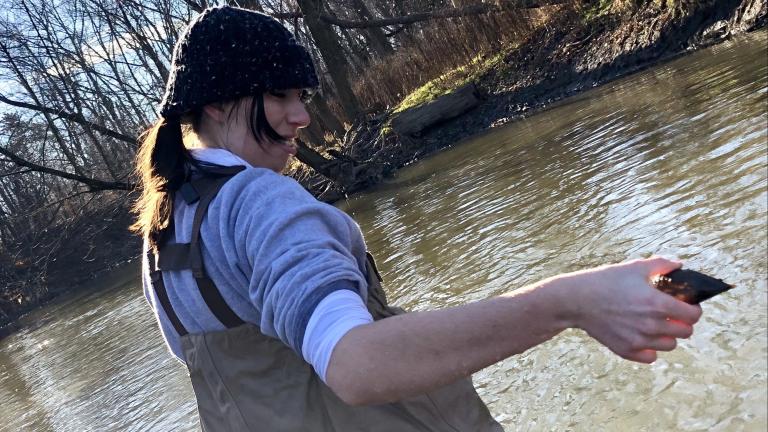 Ornate box turtles have been listed as a threatened species in Illinois since 2009. (USFWS)
Ornate box turtles have been listed as a threatened species in Illinois since 2009. (USFWS)
Although it’s known as the Prairie State, 99 percent of Illinois’ natural prairies have disappeared, according to the U.S. Fish and Wildlife Service.
That’s bad news for the ornate box turtle, a threatened species in Illinois that prefers a type of prairie characterized by dry, sandy grassland.
To help boost the species, the USFWS started an experimental “head-start” program in 2009 with just four eggs and has since reintroduced 100 of the turtles to the last and largest remaining sand prairie in the state. Most of the turtles were hatched and reared at three Illinois zoos, including two in the Chicago area.
Naibi Zoo, located near the Iowa-Illinois border in Coal Valley, was the first zoo to join the USFWS program. It received those first four eggs that were collected in 2009, and it was there that the eggs hatched and were cared for until their release at Lost Mound Sand Prairie in Savanna, Illinois, a nearly 4,000-acre preserve formerly known as the Savanna Army Depot.
The area once supported a robust population of the species, according to Jeramie Strickland, the USFWS wildlife biologist spearheading the project.
“Due to decades of military operations and heavy traffic, they were wiped out except for a few of these turtles,” said Strickland. “We only surveyed three turtles here when we started.”
 From 1917 until 2000, an army depot operated on Lost Mound Sand Prairie. (USFWS)
From 1917 until 2000, an army depot operated on Lost Mound Sand Prairie. (USFWS)
Over the past five years, the Lincoln Park Zoo and the Brookfield Zoo have joined the Naibi Zoo to help raise turtles for the USFWS program.
Each zoo incubates and hatches turtle eggs delivered to them by the agency and cares for the turtles for about a year, until they're large enough to have a better chance of survival against predators like raccoons, coyotes and skunks that prey on young turtles and nests.
“Our goal here was to raise these animals up and have them increase significantly in size,” said Dan Boehm, zoological manager at the Lincoln Park Zoo. “So when they’re released a year later, they’re quite large and past that one-year stage without having to undergo that first year in the wild of high mortality and high losses.”
Wild ornate box turtles hibernate (technically, as cold-blooded animals, they brumate) from November through March, but the turtles raised at the zoos don’t. Instead, they spend their first year eating voraciously and growing to a size equivalent to that of a four-year-old wild turtle.
Turtles in captivity “can turn all this food energy into growth because it doesn’t have to go towards keeping their bodies warm,” Boehm said. “Because they have a year-round growth season, literally, instead of close to half a year like their wild counterparts, you just get tremendous growth rates in a head-start situation like this.”
Of the 100 ornate box turtles living in a 20-acre fenced-in area at Lost Mound, 64 were raised at Lincoln Park Zoo, seven at Brookfield Zoo and 14 at Niabi Zoo. The remaining 15 were adults relocated from adjacent roads and properties.
 The USFWS tracks some ornate box turtles at Lost Mound Sand Prairie with radio transmitters. (USFWS)
The USFWS tracks some ornate box turtles at Lost Mound Sand Prairie with radio transmitters. (USFWS)
With the help of the zoos, the USFWS has reached its goal of reintroducing 100 ornate box turtles to the project site four years earlier than expected. Now that the zoos have done their part, the USFWS will look for natural nests from their reestablished turtles over the next few years.
They’ll continue studying their home range, hibernation characteristics and use of habitat at Lost Mound via radio transmitters affixed to some of the turtles.
Ornate box turtles are native to the Midwest. Before 1980, they were found in 38 Illinois counties, but recent studies report them in only 15 counties, according to the USFWS.
In October 2009, they were listed as a threatened species in Illinois, largely due to habitat loss.
The International Union for Conservation of Nature classifies them as near threatened and they’re a protected species in Colorado, Iowa, Indiana, Nebraska, Kansas and Wisconsin.
Follow Evan Garcia on Twitter: @EvanRGarcia
Sign up for our morning newsletter to get all of our stories delivered to your mailbox each weekday.
Related "Chicago Tonight" Stories
 More Mobility for Shedd Lizard, Thanks to 3-D Printer
More Mobility for Shedd Lizard, Thanks to 3-D Printer
June 30: Hiss Majesty, a 16-year-old Caiman lizard at the Shedd Aquarium, was fitted for a new prosthetic limb on Wednesday.
 5 Endangered Gray Wolf Pups Born at Brookfield Zoo, 2 Sent to the Wild
5 Endangered Gray Wolf Pups Born at Brookfield Zoo, 2 Sent to the Wild
May 13: Two Mexican gray wolf pups born at Brookfield Zoo last month were released into the Arizona wilderness as part of a carefully timed conservation effort. The species has been threatened by extinction for over half a century.
 Wild Badger Implanted with Tracking Device in Cook County
Wild Badger Implanted with Tracking Device in Cook County
March 29: Badgers are known for their elusiveness: the mostly solitary animals travel and forage at night, moving from one place to another very quickly. But wildlife biologists recently got lucky and caught one in northwest Cook County.







